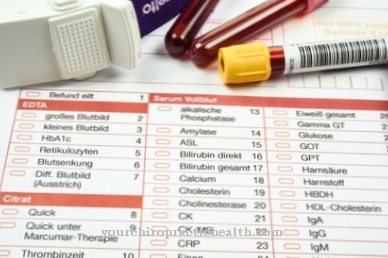At Cefazolin it is a semi-synthetic antibiotic that belongs to the group of cephalosporins. The drug belongs to the first generation of cephalosporins. Cefazolin is characterized by its bactericidal properties. The effect of the drug is primarily based on the fact that the active ingredient affects the formation of cell walls in bacteria.
What is cefazolin?
Basically, the active ingredient cefazolin belongs to the group of so-called beta-lactam antibiotics, which in turn belong to the cephalosporins. As a rule, the active ingredient is used to treat infectious diseases that occur both acutely and chronically.
It is possible to administer the drug cefazolin parenterally. For this purpose, the drug is used in powder form to prepare a suitable solution for injection or infection. The plasma half-life is usually around two hours. Most of the drug is excreted via the kidneys.
For the active ingredient cefazolin the synonyms are used in some cases Cefazolinum, Cefazolin sodium or Cefazolinum natricum used. In the market, the drug is available only in the form of solutions to be used as an injection and infusion. The drug has been approved in Switzerland since 1974.
In pharmacy, cefazolin is used in the form of cefazolin sodium. This substance is usually a white powder with low solubility in water. Basically, the drug is administered either intramuscularly or intravenously.
It only makes sense to use it in cases where the presence of sensitive pathogens is certain. Cefazolin is sometimes associated with some undesirable side effects.
Pharmacological effect
Cefazolin is characterized by a characteristic mode of action, so that the drug is suitable for the treatment of special infectious diseases. In principle, cefalozin has a bactericidal effect, i.e. it kills bacteria. The reason for this bactericidal effect is that the active ingredient affects the bacterial synthesis of the cell wall. As a result, the germs die off, as undisturbed reproduction is no longer possible. In addition, the active ingredient has a relatively short half-life, which is around 1.4 hours for intravenous administration.
However, cefazolin only works against specific bacteria. These include, for example, staphylococci, Streptococcus pneumoniae and Escherichia coli. Numerous other germs, such as Proteus vulgaris, various streptococcal strains and Enterobacter cloacae, for the most part show resistance to the drug cefazolin.
When a patient's kidneys are functioning properly, the dominant elimination half-life is approximately two hours.
Medical application & use
Cefazolin is suitable for treating numerous infections. The drug must always be dosed in accordance with the specialist information. In most cases, cefazolin is used either intravenously or intramuscularly. The main area of application of the drug is infectious diseases of the skin caused by sensitive pathogens.
In addition, the drug is also suitable for the treatment of moderate infections that affect the lungs, joints, bones, the stomach, the blood, the urinary tract or the heart valves.
It is therefore advisable to administer cefazolin in the case of bronchitis or pneumonia, for example. The drug can also be used for infections in the renal pelvis, ureter and bladder, as well as the prostate.
In addition, in some cases, cefazolin is also used for prophylaxis, whereby it is particularly intended to prevent infections that arise in the course of surgical interventions. This is the case, for example, in open operations on the heart, joints and bones. Cefazolin is also given for infections of the biliary tract, soft tissues or sepsis.
Risks & side effects
As part of therapy with the drug cefazolin, a large number of undesirable side effects and complaints are possible, which vary depending on the individual case. For example, hypersensitivity reactions and complaints of the gastrointestinal tract have been reported after the administration of cefazolin. These include vomiting, diarrhea and nausea.
In some cases, allergic reactions in the form of rashes, pruritus or urticaria can be seen, particularly on the skin near the injection or infusion site. In addition, some patients complain of loss of appetite or pain in the abdominal region during therapy with cefazolin.
Hypersensitivity reactions sometimes show fever, angioedema or, in the worst case, anaphylactic shock. Other possible side effects of the drug include hemolytic anemia, eosinophilia, leukopenia, neutropenia and thrombocytopenia.
Cefazolin must not be used under any circumstances if the patient concerned is already known to be intolerant or hypersensitive to the drug or other antibiotics from the group of beta-lactams.
In addition, the drug should not be administered during breastfeeding, as the active ingredient passes into breast milk. Even premature babies and infants in the first month after birth should not be treated with cefazolin.
In addition, it should be noted that if there is an existing allergy to penicillin, a cross allergy can occur in some cases. If side effects occur during treatment with the active ingredient cefazolin, a doctor should be consulted immediately.













.jpg)

.jpg)
.jpg)











.jpg)